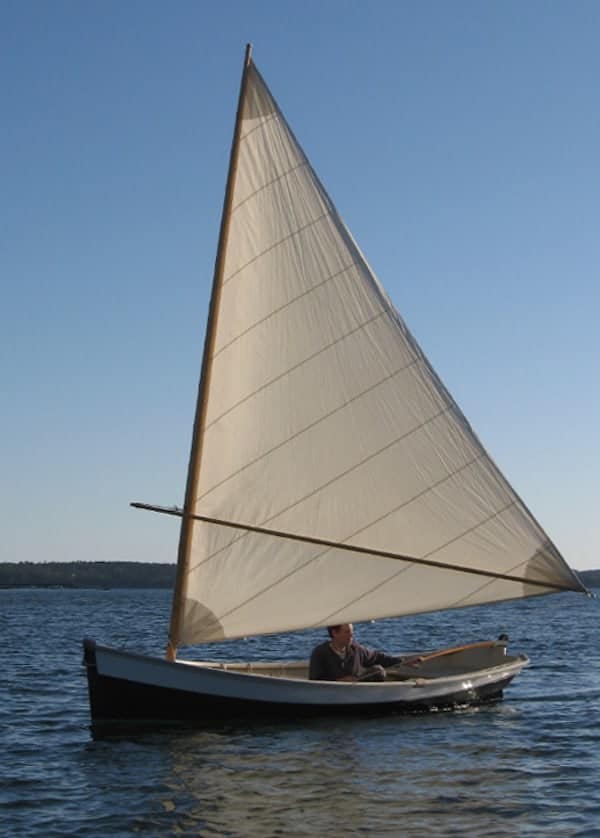Some years ago, I was asked to draw a small version of the traditional skiff once commonly used by Chesapeake Bay crab fishermen. I love this kind of project: converting old working boats for simpler plywood construction, with amateur builders in mind. Although the use of plywood and epoxy can make the structure much simpler, I always tryto include a bit of traditional detailing, so that the old-timers will have to look twice. I never cease to be in awe of the aesthetic qualities that our grandfathers insisted upon in their possessions, whether they be fishing boats, woodworking tools, or even machine tools. Perhaps they felt that owning beautiful implements was compensation for the long hours they spent at work.
. . . sign up to the right to get immediate access to this full post,
plus you'll get 10 of our best videos for free.
Get Free Videos& Learn More Join Now!!for Full Access Members Sign In



Burton Blais says:
I can attest to the fine sailing qualities of Doug’s crab skiff design, having built one and rigged her with the rectangular sprit rig (incorporating a set of reefing points). She is my mainstay for cottage sailing – a beautifully balanced helm and a joy under way in a summer breeze. My iteration is a bit more elaborate in that I built her with side decks and coamings, and she is a very dry boat for it. Nothing better than to park my big carcass on the floor boards, slouched against the coaming, scooting back and forth on our lake. I like to think that even the booming power boaters experience a twinge of envy at the sight as they rake me with their merciless wakes.
Peter Erickson says:
Chapelle: Page 125 has the lines of a sweet sharpie….a Florida Cedar Keys sharpie. On my desk I’ve been looking at these lines, enlarged to 1 inch equals 1 ft., and with one
sail instead of two (see page 109 leg o’ mutton sail). Also researching carbon fiber sectional
mast, keeping on mind the “cardinal rule” per your Chesapeake Crab Skiff postings that mast fits within. Jerry Rose of Sedgwick, ME has recommended that the crab skiff might be what I want for fly fishing, poling, rowing, sailing the inland waterway in Florida next winter.The Cedar Keys model was typically built as small as 18 – 22 ft. I think I would drop down to about 15’ 6″ and shorten the stern to make it proportionally a little wider, especially back aft. This stability aft when poling is one reason that the sharpie might be more suitable for my purposes in the waters mentioned above. You have stated your fondness for adapting traditional small craft to contemporary construction materials and methods. Would this sort of a project be of interest to you? -Peter Erickson – Newbury, MA
Doug Hylan says:
Hi Peter, In some ways, this would be a very easy conversion, given the flat bottomed construction of the original. The Chapelle boat shows quite a bit of twist to the topside panel, a result of the slight tumblehome in the stem profile. This could be difficult to achieve in a large piece of plywood, but there are work-arounds for this.
The larger problem comes from the big reduction in size. Like many a lovely old workboat, part of the appeal comes from their great length and low freeboard. As you decrease the size of a design, it is necessary to reduce both of these “appeal factors” for the sake of safety, sometimes to the point that much of the original charm is gone. Beam would also need to be increased substantially.
Perhaps the first step would be to come up with a set of lines that would be appropriate for the desired size of boat. Then, you could put this drawing on your desk and see if, after a few days of gazing, the sirens still sang to you.
This kind of project needs to start with a phone conversation that will give me better insight into your needs and priorities. Let me know if you would like to move ahead!
Peter Erickson says:
Thanks, Doug:
Per your reply, above, I have drafted the lines with a single mast (dotted on the Chapelle lines drawing) and also a version with the mast stepped a little farther forward. Both versions that I have drafted shortens the model aft enough to lose the counter stern, as pretty as it is, but in a smaller boat than the original, this would give more initial stability for poling, I think. This is a small boat, at under 16′ that I want to be able to walk all over. In shortening the counter, the centerboard trunk also came forward half the distance of the reduction. As you have suggested, I will: “put this drawing on my desk and see if, after a few days of gazing, the sirens still sing.” (Ernest K. Gann reference here?)…..then I will give you a call. Thank you, again, -Peter
Paul Fielder says:
I am really glad that I signed on to OCH, I am looking to build my first wooden boat possibly something simple as a skiff. I really like Doug Hylan’s designs. I think this is a great web site well done all you guys that have worked so hard on OCH. Paul Fielder.
Steve Stone says:
Thanks Paul. We always enjoy hearing these stories.